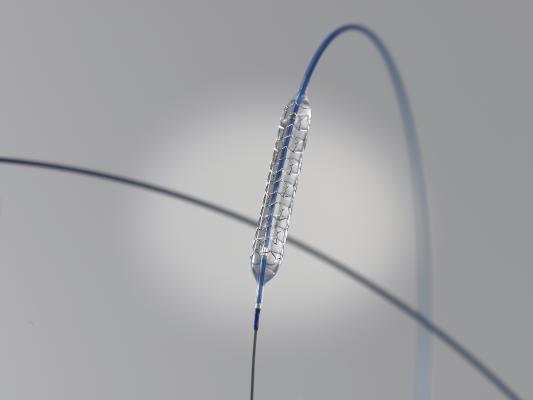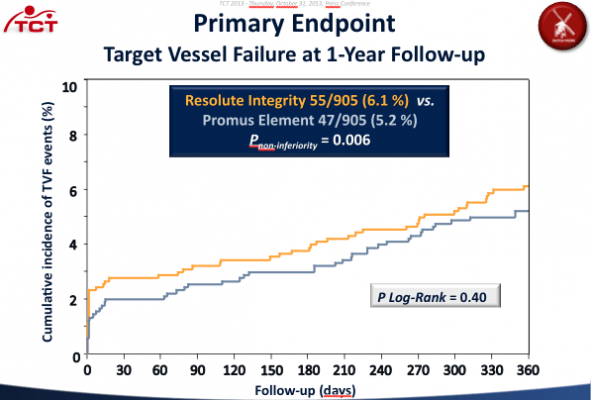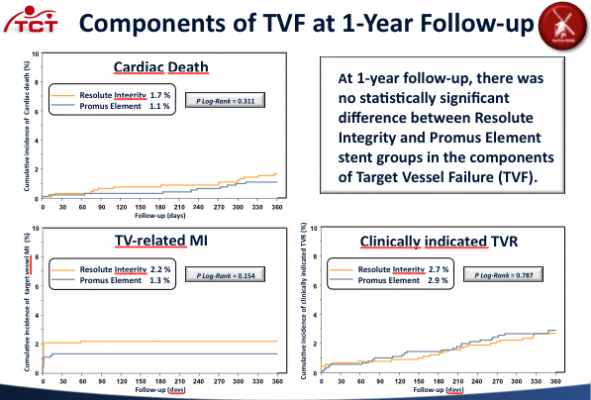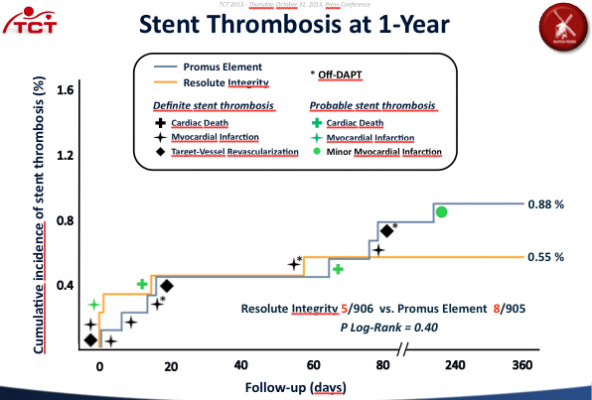
Boston Scientific Promus Element stent
November 1, 2013 – In the first head-to-head randomized controlled trial of third-generation durable-polymer drug-eluting stents for the treatment of coronary artery disease in an all-comers patient population, the Medtronic Resolute Integrity and the Boston Scientific Promus Element performed similarly on all measures except longitudinal strength, which favored the Medtronic device.
Results of the DUTCH PEERS (Twente II) clinical trial demonstrate comparable safety and efficacy of two third-generation permanent polymer-based drug-eluting stents with low rates of adverse clinical events and establish the non-inferiority of the newest Resolute zotarolimus-eluting stent. The findings were presented today at the 25th annual Transcatheter Cardiovascular Therapeutics (TCT) scientific symposium.
Third-generation permanent polymer-based drug-eluting stents (DES) with novel flexible designs were developed to improve stent deliverability in challenging anatomical lesions and to improve stent alignment within the vessel wall, while maintaining the anti-restenotic potential of newer generation DES systems. DUTCH PEERS (Twente II) follows the Twente trial, which was presented at TCT 2011 and examined second-generation drug-eluting stents with the same drugs and coatings but different stent platforms.
DUTCH PEERS was a multicenter, prospective, single-blinded, randomized controlled study in patients requiring percutaneous coronary interventions (PCI) with DES implantation. The study was performed in four PCI centers in the Netherlands (Thoraxcentrum Twente, Enschede; Rijnstate Hospital, Arnhem; Scheper Hospital, Emmen; Medical Center Alkmaar, Alkmaar). The primary endpoint was the composite target vessel failure (TVF) at one-year, defined as cardiac death, target vessel revascularization, or myocardial infarction (MI) attributable to the target vessel or not attributable to another vessel.
A total of 1,811 patients were randomly assigned to treatment with third-generation cobalt-chromium zotarolimus-eluting stents (906 patients; 1,205 lesions) or platinum-chromium everolimus-eluting stents (905 patients; 1,166 lesions). The study population (age 63.9±10.8 years, range 21–91 years; 73.0 percent male) was an “all-comers” population comprising 58.6 percent of patients with acute coronary syndromes (20.4 percent of all patients presented with an acute ST-elevation myocardial infarction). Of all 2,371 lesions, 65.7 percent were ACC/AHA lesion type B2/C. Follow-up data for 99.9 percent of the randomized patients were obtained.
TVF occurred in 6.1 percent (55/905) patients assigned to zotarolimus-eluting stents and 5.2 percent (47/905) assigned to everolimus-eluting stents. Non-inferiority of the zotarolimus-eluting stent was confirmed with an absolute risk difference of 0.88 percent (non-inferiority p-value = 0.006). There was also no significant between-group difference in individual components of the primary endpoint and other secondary clinical endpoints.
In both stent groups, definite-or-probable stent thrombosis rates were low. Definite-or-probable stent thrombosis rates were 0.6 percent (5/905) in the zotarolimus stent and 0.9 percent (8/905) in the everolimus stent (p value=0.40). Notably, there was no definite stent thrombosis beyond three months from stenting, reaffirming the safety of newer generation DES platforms.
“The clinical outcome of this trial was excellent – particularly when considering its high proportion of complex patients with acute myocardial infarction at presentation – and may represent a challenging touchstone of novel stents and scaffolds,” said Clemens von Birgelen, M.D., Ph.D., the principal investigator of the trial. Von Birgelen is co-director of the Department of Cardiology at Thoraxcentrum Twente and professor of cardiology at University of Twente in the Netherlands.
“Both permanent polymer-based stents were similarly efficacious and safe in treating all-comers with an excellent clinical outcome,” von Birgelen said.
Stent Design Might be Reason for Stent Thrombosis
While the incidence was low, the difference in stent thrombosis between Resolute and Promus was discussed in sessions at TCT. Mamas A. Mamas, BM, BCh, MA, DPhil, MRCP, from Manchester Institute of Cardiovascular Sciences, U.K., offered an analysis of the FDA's Manufacturer and User Facility Device Experience (MAUD) database to examine real-world reported cases of coronary stent fractures that can lead to stent thrombosis. He found longitudinal stent deformation was the most commonly listed cause of stent strut fractures. Of all cases reported between 2010 and 2011, 80 percent (34 of the cases reported) involved the Promus element. Mamas added most of these fractures occurred in complex lesions, such as ostial, bifurcation, severe angulations and long lesions.
The Dutch Peers (Twente II) trial was equally funded by Boston Scientific and Medtronic. Dr. von Birgelen reported being a consultant to Abbott Vascular, Boston Scientific, and Medtronic. He has also received a travel grant from Biotronik and lecture fees from Biotronik and MSD.
For more information: www.crf.org





 June 11, 2025
June 11, 2025 








